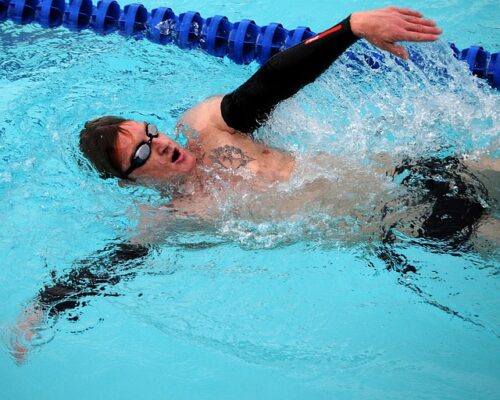Up next in our 4-part physical therapy for swimmers series is a crowd favorite, backstroke!
Backstroke is often the first or second stroke that a swimmer masters. It appeals to many swimmers by allowing them to breath through the entirety of the stroke and keep their face out of the water.
But, this does not mean that the backstroke is simple (we see many backstrokers as physical therapy clients in our McLean facility). Backstroke involves asymmetrical arm and leg motions, requiring coordination of upper and lower rotation around a fixed neck and head. This stroke requires strong shoulder external rotation, adduction, and a powerful kick to keep the swimmer afloat on their back.
If you’re curious about the differences in muscle groups between this stroke and the other’s we’ve already covered, here they are below!
1. Latissimus Dorsi and Rotator Cuff: These two upper-body muscles play a crucial role in backstroke by providing the primary propulsion during the arm pull phase. As you extend your arms outwards and sweep them in a circular motion, the rotator cuff initiates the “catch” and the lats engage to follow through, generating forward momentum.
2. Deltoids and Pectorals: Situated at the top of the shoulders, the deltoid muscles assist in raising the arm during the recovery phase. The pec major and pec minor are responsible for an efficient recovery out of the water to complete the propulsion phase. They help the rotator cuff in stabilizing the shoulder joint and contribute to the overall power and efficiency of each stroke.
3. Erector Spinae: Found along the length of the spine, the erector spinae muscles provide support and stability, especially during the kicking phase of backstroke. They help maintain proper body position and alignment in the water.
4. Quadriceps and Hip Flexors: While the arms perform the pulling motion, the legs play a crucial role in propulsion through the flutter kick. The quadriceps, located on the front of the thigh, and the hip flexors, situated at the front of the hip, contract and extend with each kick, driving the body forward.
5. Gluteal Muscles: The glutes, comprising the gluteus maximus, medius, and minimus, provide power and stability during the kick. They work in tandem with the quadriceps and hip flexors to generate propulsion and maintain body position.
6. Core Muscles: Last but certainly not least, the core muscles— including the abdominals, obliques, and lower back—play a vital role in backstroke. They provide stability and rotational control, allowing for efficient transfer of power from the upper body to the lower body and ensuring a streamlined position in the water.
Due to the heavy demand and unique position of the arm during the catch position of pull, the rotator cuff is the muscle group susceptible to overuse and injury with high volumes of backstroke swimming (the most common swimming injuries that we see in physical therapy with swimmers). Injuries to the chest and pectoral muscles are also common.
These muscles must be strong to prevent overuse injuries. Additionally, the hips and thoracic spine must be mobile so that the rotational movement of each stroke cycle can be done correctly.
Below are some exercises that help increase strength of the rotator cuff and pecs, as well as mobility drills that directly correlate to the movements required for backstroke!
1. External rotation focused shoulder strength: Targets the initial catch
– Rotator cuff screwdriver
– Kettlebell windmill
2. Adduction focused chest strength: Targets the final catch and recovery phase
– Standing chest fly
3. Thoracic spine rotational mobility: Important for efficient shoulder rotation to maximize the depth of the catch phase
– Wall thoracic rotations
If you are a swimmer looking for ways to optimize your performance in the water or address an injury with physical therapy, contact us to learn how much more you can do to step up your game!
